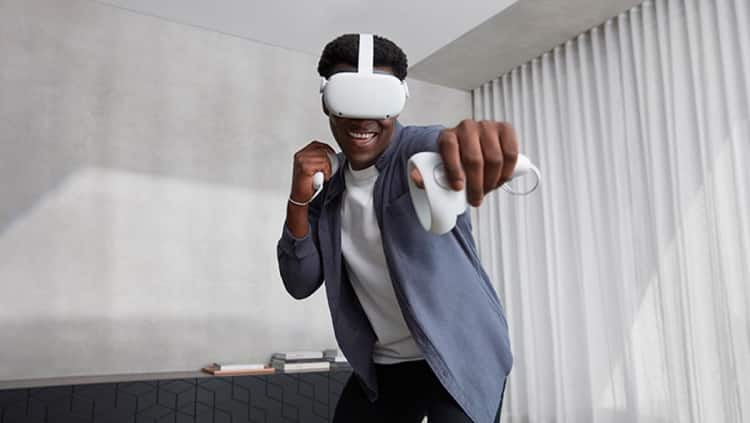Parenting in the virtual world is quite a challenge
Wed 12 Jan 2022
In the summer of 2021, Allen Roach saw something that really upset him: His then-11-year-old son, Peyton, used a sword to slice off the characters legs as well as arms in a virtual reality medieval fantasy game which he then threw off a bridge.
It did all happen in VR, but for Roach — who viewed the entire scene while monitoring his son’s VR gaming on a computer screen that mirrored what Peyton was doing his headset — it felt uncomfortably real.
Roach understood that when Peyton looked down in the VR world he was seeing a weapon held in virtual hands, it was not just a plastic game controller. It didn’t matter that it was a single-player game, which meant that the characters weren’t represented by other human players.
“It bothered me in a way it doesn’t on flat screens even because they’re doing it with their hands in physical presence,” he said.
Roach, who lives in Kansas City, Missouri and works as community manager for VR-based learning platform Edstutia, sat down with Peyton at the time and talked about what had happened.
He also did not let Peyton as well as his other children play that game.
Roach is part of a growing number of parents guiding themselves in a new era of technology where it is learning on the go. Today, more kids have access to VR headsets than ever before — and with it, access to an expanding virtual world of games, avatar-driven hangouts, and many more activities.
Apps may have their own safety features such as the ability to block or mute other users — popular VR social app Rec Room limits users under age 13 to “junior accounts” that disable the app’s voice-chat function — but there are no controls on Quest 2 itself specifically intended to limit how younger users use the headset. (Parents can set a password to lock the device; that simply prevents unauthorized use.)
Companies selling headsets often set age limits for the gadgets.
The Quest 2, for example, is intended for ages 13 and up, and requires a Facebook account, which is limited to those 13 and up. But parents may disagree or not even notice. The only indication of an age limit on the Quest 2 box, for instance, is in small type on the rear corner of a slide-off paper sleeve, making it the most disposable part of the headset’s packaging.
Meta spokesperson Kristina Milian said that the company is “constantly looking to improve upon the protections and controls” offered to users, and that Quest devices were “not designed” for children younger than 13. Milian also said that its “headset packaging, health and safety warnings [and] onboarding safety video” make this age restriction “clear.”
But some parents feel they have to come up with their own rules and VR-safety strategies on the fly. These range from watching kids’ every virtual move-in real time via a smartphone or other display, to limiting what they can download — or even only allowing them to use the technology with an adult.
“I think it should be easier for parents,” said Amber Albrecht, a Bend, Oregon-based parent who let her daughter Rylee, 10, and son Cooper, 8, buy Quest 2 headsets with Christmas money in December.
Sometimes I feel like somebody’s watching me
Normally, parents can see what their kids are watching or playing on a screen like a TV, tablet, or smartphone. It’s trickier with VR, however, as the display sits on the user’s face, hidden from anyone around them.
Both Roach and Albrecht said that one way they got around this is by using a feature that is intended to let non-VR users in on what’s happening behind the headset, known as casting. This option lets you see what the VR headset-wearer is doing in real-time on a smartphone or other flat screen.
“Any time my kids jump into VR I take advantage of the casting feature,” said Roach, whose family has both a Quest 2 and a PlayStation VR headset, the latter of which does offer parental controls such as playtime restrictions via a PlayStation 4. In his home, he said, it’s actually easier to monitor their three-dimensional activities than two-dimensional gaming on the PS4, which is tucked away in a bedroom.
In hopes of preventing — or at least minimizing — negative experiences in virtual spaces, Roach and other parents said they’re monitoring the apps their kids download and setting rules about what types of content are off-limits. Roach said his kids aren’t allowed to download any apps, though they can suggest titles to him and he’ll research them (and, typically, play them himself) to ensure they’re appropriate. His experience with Blade & Sorcery helped him settle on a no-realistic-violence policy for VR play, but he’s okay with cartoonish brutality.
Albrecht, who works in public relations in the tech industry, doesn’t allow any VR apps that include guns, violence, or zombies, she said. Since she set up both her kids’ Quest 2 headsets with her own Facebook account, which connects to the Oculus app on her phone, she can check the app to see if they’ve downloaded any free apps. The kids use the headsets next to her or her husband, she said, where the adults can hear (via the Quest 2’s built-in speakers) what’s going on, too.
For all the potential risks, Albrecht and other parents said they also see how VR can be fun and useful for their kids. “It’s also like this new frontier of their social lives, where they’re learning to communicate,” she said. “We work in a remote world. They have to learn those skills, too.”
While casting and limiting types of content kids can access may help adults track what their children are doing, it doesn’t eliminate the possibility that a child will encounter violence or abuse in a virtual setting.
“Things you see you can’t un-see,” said Kavya Pearlman, founder and CEO of XR Safety Initiative, whose efforts include the creation of child-safety standards for VR and augmented reality, or AR.
Additionally, very little is known about how VR usage can impact children over time. A range of studies have been conducted over the years, but it remains unclear whether and how VR can harm a child’s eyes, brain, or psychological development. Pearlman hopes to see more research this year.
Beyond monitoring what kids are doing when wearing a headset, Pearlman recommends talking to kids about not talking to strangers in VR. The XR Safety Initiative lists a host of recommendations for parents whose kids use VR online — including that they check individual apps for the existence of different safety settings. Pearlman also advised that kids spend no more than 20 minutes using VR at a time, though she acknowledged it’s an arbitrary time limit.
“I think the time limit really depends on the amount of stimulant the experience gives to the child, which we can’t really calculate on the fly,” she said.
Even if parents don’t set a time limit, however, a quirk of existing wireless VR headsets may become a benefit for those weary of tracking their kids’ virtual activities, as they only have a few hours of charge and may run out far faster than other gadgets kids might use.
“I will say that is the other parental control: the battery life. It does not last that long,” Albrecht said.
Source: Agencies

 Apr 20 2024
Apr 20 2024













